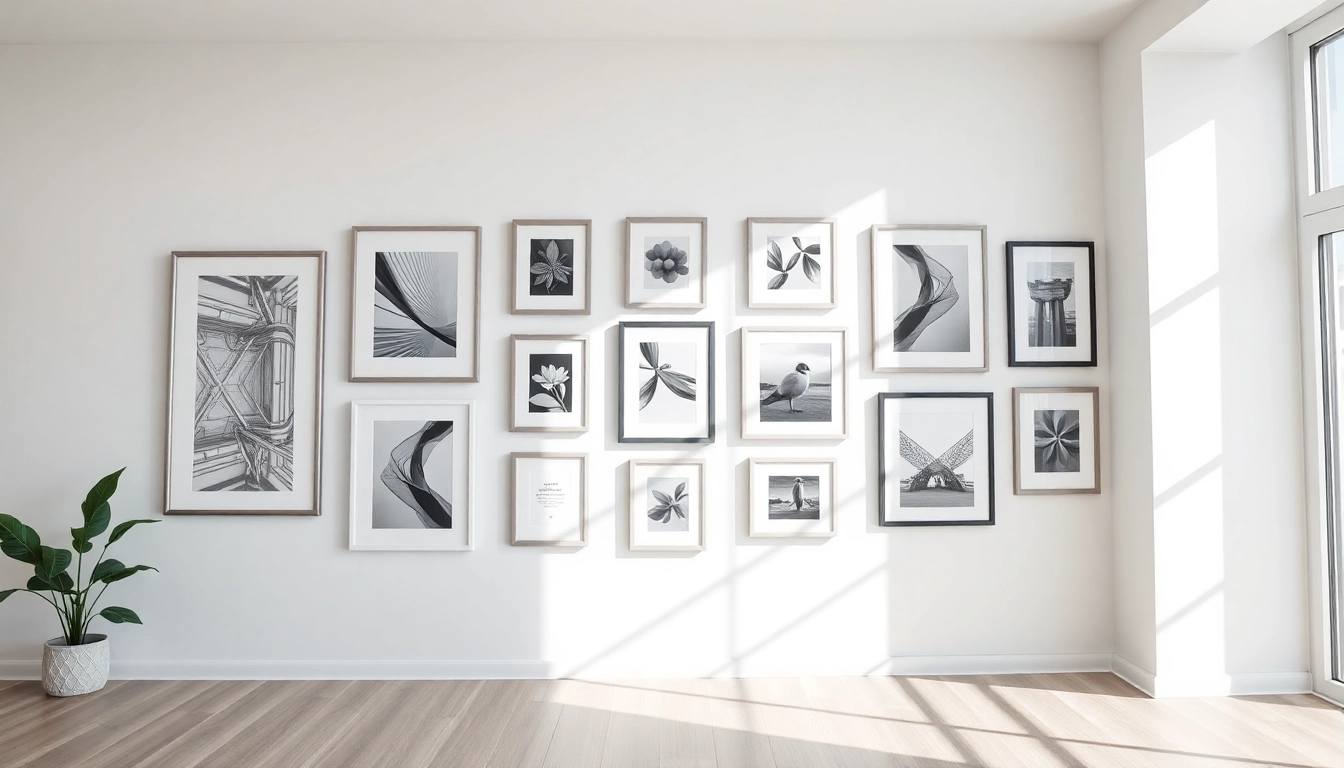Understanding Modern Design Picture Frames
Modern design picture frames are not merely functional items; they are an essential element of interior decor, transforming spaces with their unique aesthetic appeal. With a blend of sleek lines, bold colors, and innovative materials, these frames embody the principles of modern design. They serve not only to showcase artwork and photographs but also as individual art pieces that can enhance any setting—be it a cozy living room, a professional office, or a chic gallery. Modern design picture frames resonate well with contemporary aesthetics and can be tailored to complement various artistic expressions.
What Defines Modern Design in Frames?
Modern design is characterized by simplicity and functionality, striving to create pieces that are both utilitarian and aesthetically pleasing. In the context of picture frames, this means sleek, unembellished lines, a minimalistic approach, and an emphasis on the artwork rather than on ornate frame designs. Often made from materials like metal, wood, and acrylic, modern frames boast clean profiles and a sophisticated finish, making them the perfect companion for contemporary artworks and photographs.
An essential point in modern design is the integration of form and function. Every detail in a modern picture frame—from the angle of its edges to the way it mounts on the wall—is intended to create harmony within the overall design of the space. Additionally, the versatility of modern design frames makes them suitable for various artistic media, from paintings and drawings to digital prints and photography.
The Role of Material and Texture in Modern Frames
The choice of material is crucial in modern picture frames, influencing not only their appearance but also their interaction with light and surrounding elements. Metal frames, for example, can impart an industrial edge, while wooden frames add warmth and organic texture. Acrylic is emerging as a popular choice for those looking for a sleek, contemporary look that also weighs less than glass, making it easier to hang and transport.
Texture is another significant element when choosing modern frames. A smooth finish might exemplify a clean and polished look, while a textured frame could provide contrast against flat artwork, inviting viewers to engage more deeply with their visual experience. When selecting a frame, consider how its texture complements or contrasts with the materials and hues of the artwork it will hold.
Popular Styles and Trends in Modern Picture Framing
Multiple styles and trends currently define the landscape of modern picture framing. One particularly popular trend is the use of oversized frames that create a dramatic effect around smaller pieces of art, transforming them into focal points within a room. Additionally, the concept of “floating frames” allows for an illusion of space around the artwork, enhancing visual interest.
Another noteworthy trend is the use of unconventional shapes and designs. Geometric frames or asymmetric designs can dramatically alter the viewer’s perception, introducing a playful element to traditional framing practices. Moreover, the focus on sustainability has led to the rise of eco-friendly materials and practices, appealing to environmentally conscious consumers. The color trend also shifts towards muted, earthy tones or vibrant colors that can either harmonize or stand out against the artwork.
Choosing the Right Modern Design Picture Frames for Your Artwork
Choosing the appropriate frame for your artwork is an art in itself. A well-selected frame can elevate the overall expression of a piece, enhancing its visual impact and contributing to the intended aesthetic of the space. Here are several factors to consider to ensure that your chosen frame aligns effectively with your artwork.
Factors to Consider When Selecting Frames
Several factors come into play when selecting a frame for your artwork—dimensions, style, material, and color. To begin with, measure your artwork’s dimensions accurately, as this will inform your choice of frame size. The overall style of your space and the artwork should align; for instance, a traditional painting may require a more ornate frame, while a minimalist photograph could benefit from a simple, clean border.
Material choice is also paramount. Consider whether a wooden frame aligns with the area’s ambiance, or if a metal frame might provide the clean lines you desire. Remember to also evaluate how the frame’s finish (matte versus glossy) will interact with the artwork under various lighting conditions, influencing the light reflection and color perception.
How Frame Color Affects Overall Aesthetic
The color of a frame can fundamentally affect the overall aesthetic of both the artwork and the surrounding space. Neutral tones, such as whites, blacks, and grays, are excellent for highlighting the artwork without drawing attention away from it. These colors ensure that the frame acts as a supportive element rather than a distractive one.
On the other hand, bold, vibrant frames can serve as statement pieces, enhancing the visual narrative of the artwork. When selecting frame colors, consider not only the colors present in your artwork but how these colors relate to other elements in your space. Providing a visual connection between the artwork and the room can create a cohesive design story.
Pairing Artwork with Complementary Frames
The process of pairing artwork with complementary frames involves strategic decision-making. A good starting point is to analyze the predominant color palette and style of the artwork. If your artwork has warm undertones, selecting a frame in a similar warm hue might enhance its visual appeal. Conversely, cooler tones in the artwork can be brilliantly complemented with frames in shades of blue or green.
Additionally, think about the art style itself. Abstract pieces might benefit from frames that contain geometric lines, while classic portraits may warrant traditional or ornate frames. Keep in mind that the frame should not only match the artwork but also alleviate or enhance the intended emotions those pieces convey.
Best Practices for Displaying Modern Design Frames
Displaying your modern design frames—not just the artwork—is an extension of your style and can significantly impact the atmosphere of your space. To refine your approach, consider how arrangements and placements can enhance visual appeal and storytelling within the environment.
Arranging Frames for Visual Impact
When arranging frames, whether on a wall or a shelf, the goal is to create a visually pleasing and balanced layout. Start by determining the various dimensions of the frames you intend to use. A well-thought-out arrangement may include a central focal piece flanked by larger frames or grouped smaller frames creating an eclectic yet cohesive arrangement.
Utilize the principles of balance, contrast, and alignment to guide your arrangement. Asymmetrical designs can lend a casual vibe, while symmetrical arrangements are more structured and formal. Furthermore, feel free to mix frame styles to add layers and depth, ensuring a more dynamic visual experience.
Creating a Gallery Wall with Modern Frames
A gallery wall is a fantastic way to showcase your collection of modern design frames. To create an impactful gallery wall, begin by laying out a plan on the floor, arranging your frames until you achieve a look that feels right. Consider varying frame sizes, colors, and orientations to create visual diversity, while still maintaining some thematic elements throughout.
Leave a uniform space between frames to ensure a clean and organized appearance. As a rule of thumb, a distance of 2 to 4 inches between frames often yields a suitable look. Alternatively, using a picture ledge can offer the flexibility to change pieces frequently, allowing for a more evolving gallery that reflects your current tastes.
Framing Photos vs. Art: A Different Approach
The approach to framing photographs versus artworks can differ significantly. Photographs often require frames that enhance their storytelling qualities, while art pieces may necessitate more emphasis on the overall composition and aesthetic. For photographs, consider frames that complement their themes, such as playful colors for family shots or subdued hues for black and white images.
In contrast, artwork may call for framing techniques that offer depth and dimension. For instance, combining a mat board beneath the artwork can create separation and visual space, allowing the eye to focus on the art without distraction. Remember that, regardless of the medium, the frame should enhance the visual narrative, creating a harmonious connection between the piece and its display.
DIY Tips for Customizing Modern Design Picture Frames
Customizing your modern design picture frames can imbue your space with a personal touch, making it uniquely yours. The following DIY tips can help you transform standard frames into custom statements that resonate with your style and creativity.
Painting and Finishing Techniques for Personal Touch
One of the simplest ways to customize a modern frame is through painting. Selecting a color that complements your artwork or room decor can breathe new life into a plain frame. Before painting, prepare the surface by lightly sanding it to allow for better paint adhesion. Choose high-quality acrylic paint for durability, and consider adding a protective finish, such as a clear sealant, to increase longevity.
In addition to paint, you can experiment with finishes. A distressed finish can give a rustic vibe, while a glossy finish can enhance the modern aesthetic. Allow each new layer to dry thoroughly, and don’t hesitate to engage in layering techniques to develop depth and character in your customized frames.
Adding Personal Elements to Your Frames
Incorporating personal elements into your frame can elevate it from functional to a treasured memory holder. Think beyond traditional displays and consider adding embellishments—such as fabric, wallpaper scraps, or even family heirlooms—to create a multi-dimensional effect. You may also explore using washi tape or fabric trim along the edges of the frame for an added pop of color or pattern.
Personalization can also extend to using photographs as backgrounds behind the artwork. A collage of significant moments or locations can create a special context for the displayed pieces, enhancing the emotional connection to your arrangement. Ultimately, the key is to let your creativity flow while ensuring that these elements harmonize with the overall design theme.
When to Seek Professional Custom Framing Services
While DIY techniques can unleash creativity, there are times when seeking professional framing services makes sense. If you possess an artwork with significant value or sentiment, consulting with a professional is advisable to ensure that the framing method preserves and protects the piece effectively. Professionals bring expertise in choosing archival-quality materials that prevent acid damage and fading over time.
Additionally, complex framing designs, such as shadow boxes to display three-dimensional objects, are best done by someone with experience. Engaging with a professional framer can free you from the challenges of selecting the right materials and executing intricate designs while ensuring that your artwork remains in pristine condition for years to come.
Maintaining and Caring for Modern Design Picture Frames
Modern design picture frames require regular maintenance to keep them looking their best. By adhering to simple care protocols, you can protect your frames and the precious artwork within them, ensuring longevity and uninterrupted enjoyment.
Safe Cleaning Methods for Different Frame Materials
Cleaning methods vary based on the frame’s material. For wooden frames, a soft, dry cloth is usually sufficient, while occasional polishing can enhance its luster. Metal frames may require a more careful approach, using a damp cloth for cleaning, followed by a thorough drying to prevent rust or corrosion. For acrylic frames, be cautious; a microfiber cloth is ideal to avoid scratches. Never use ammonia-based cleaners, which can damage the finish.
Always ensure that no excess moisture seeps into the joints of a wooden frame and that metal frames are dry before being re-hung. Regular dusting should be part of your maintenance routine to keep frames looking fresh and clean.
Protecting Frames from Dust and Damage
To mitigate dust accumulation, consider the placement of your frames. Avoid positions near windows or high-traffic areas where dust is likely to settle. For added protection, use glass or acrylic casing, which can shield artwork from both dust and UV light, preserving colors and preventing fading.
For frames displayed in areas susceptible to moisture, such as kitchens or bathrooms, prioritizing moisture-resistant materials will help deter deterioration. Regularly assess your frames for any signs of wear or damage to ensure they continue to showcase your artwork in the best possible light.
How to Store Frames When Not in Use
If you need to store your modern design frames, do so with care. Begin by wrapping each frame in a soft cloth or bubble wrap to protect against scratches and impacts. Keep them upright, either in a dedicated storage box or in a space with limited exposure to moisture and temperature fluctuations, which can warp and damage frames over time.
When feasible, consider having a rotation system where you display different pieces throughout the seasons. This not only keeps your decor fresh but also minimizes wear on any single item. However, ensure proper storage practices are followed during these transitions to maintain the integrity of your frames and artwork.



